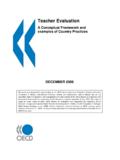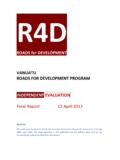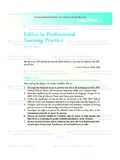Transcription of Common issues affecting Lessons Learned …
1 1 i-eval THINK Piece, No. 9 Common issues affecting monitoring and evaluation of large ILO projects Strategies to address them Robert Lahey international labour Office evaluation Office November 2015 i-eval THINK Piece, No. 1 Lessons Learned Utilizing Lessons Learned from project evaluations in policy decision making Dr. Ralph Maurer international labour Office evaluation Unit March 2012 Common issues affecting monitoring and evaluation of large ILO projects Strategies to address them By Robert Lahey The responsibility for opinions expressed in this document rests solely with the authors. The publication does not constitute an endorsement by the international labour Organization. This document has not been subject to professional editing.
2 Page i Table of Contents 1. Introduction .. 2 2. Background: What are the effective measurement tools of RBM? .. 2 3. Historical performance of M&E in ILO 3 4. Findings: Common issues affecting M&E and evaluation of large ILO projects .. 4 5. Conclusions: What needs to be addressed to improve M&E .. 6 6. Recommendations .. 9 2 i-eval Think Piece Common issues affecting M & E in large ILO projects 1. Introduction This Think Piece1 draws on recent evaluability assessments of high-budget ILO projects to ascertain how well the ILO is performing at the project level in terms of measuring, monitoring and using results information. The purpose is to identify any Common issues affecting monitoring and evaluation (M&E) and propose suggestions on how the ILO could improve its results-based management (RBM).
3 In so doing, the paper points to the particular stage of the project cycle where more attention on M&E development is likely needed. For ease of reference, part 2 provides a brief background on what the organization should expect from new projects capability to manage for results. Part 3 gives an historical overview of the performance of M&E implementation in ILO projects Part 4 draws on recent evaluability assessments of projects with a budget over US$5 million to identify Common issues that continue to plague M&E implementation and negatively affect eventual evaluations. Conclusions are given in part 5, highlighting issues and the relevant stage in the project cycle which needs to be addressed with corrective action. Finally, the paper offers recommendations for action in part 6.
4 2. Background: What are the effective measurement tools of RBM? In broad terms, managing for results means clearly defining the results expected, delivering the project, measuring and evaluating performance, and making subsequent adjustments to improve both efficiency and effectiveness. It also means reporting on performance to key audiences. In other words, the foundation of RBM is accurate and timely performance information. It is both a top-down and bottom-up exercise, as managers and the management system in general need to implement a systematic information regime that measures, evaluates and reports on key aspects of projects and their performance. In this respect, the tools of monitoring and evaluation (M&E) provide the needed instruments.
5 Effective RBM requires that each project during its design phase has articulated the underlying theory of change that provides the rationale for project intervention. A 1 This Think Piece was prepared by Robert Lahey, an independent external consultant who was the founding head of Canada s Centre of Excellence for evaluation and, over the past decade has served as an advisor to international agencies and governments on building results-based monitoring and evaluation capacity at program, organizational and national levels. 3 i-eval Think Piece Common issues affecting M & E in large ILO projects results chain (also known as a log frame or logic model) links the resources and activities to the results (outputs and outcomes) which the project is expected to achieve, identifying the key steps along the way.
6 A comprehensive theory of change implicitly underlying project logic also identifies the expected client reach and the set of assumptions and risks upon which project success depends. This includes identification of environmental conditions and other influencers or key groups and that could impact project objectives. Chart 12 identifies a comprehensive list of elements to be addressed by project managers when designing a theory of change and log frame. Performance indicators, both quantitative and qualitative in nature, are derived for each output and outcome and a performance measurement strategy is crafted that identifies how each indicator will be measured (data source, measurement approach, frequency of measurement, etc.). Some indicators may be measured through implementation of ongoing monitoring systems, others via special data collections, and others via ad hoc but more comprehensive evaluation .
7 The performance measurement strategy is put in place in an M&E plan, with the intent that some elements of information are being gathered and used on an ongoing basis by project and senior managers to assist in implementation and decision-making. Other longer-term results information would be measured and analyzed at the time of evaluation (midterm and final) using the ongoing monitoring information as well as data/information gathered via primary data collection methods. In sum, development and implementation of results-oriented systems need to have both a short-term and longer-term perspective and utility and have a clear focus on learning. There is a central role for the theory of change in identifying what , why and when to measure performance. The how aspect of measurement is usually an iterative process and one that revolves around using the tools of M &E cost-effectively.
8 But, as discussed below, this broad approach to tool development and use often has gaps that eventually limit the development and effectiveness of RBM. 3. Historical performance of M&E in large ILO projects Over two-thirds of ILO independent evaluations flag poor or non-existent monitoring and evaluation (M&E) approaches and practices as primary constraints to project 2 Both Chart 1 and Chart 2 appear at the end of this paper. 3 Guidance Note 16, August 2014. See also ILO. evaluation Office, Annual evaluation Report (Geneva) 2015, p. 20. 4 i-eval Think Piece Common issues affecting M & E in large ILO projects It is for this reason that the ILO evaluation Office (EVAL) has targeted the growing number of higher-budget projects for additional support in both planning and implementing effective M&E designs, focusing on the need to better prepare projects to document their effectiveness and results.
9 Procedures4 have been implemented that involve both EVAL and the Partnership and Development Department (PARDEV) to improve M&E plans and practices for projects with budgets over US$5 million. These procedures have been incorporated into the recently updated ILO Development Cooperation Internal Guidance But, is this sufficient? Evaluability assessments (EA) of projects over US$5 million undertaken over 2014-2015 have underscored the importance of the front-end investment in M&E during the design and inception phases of projects. Observed weaknesses in the articulation of project theories of change, as well as the M&E Plans, are limiting the ability to measure and report on results. This has implications for both ongoing management decision-making as well as the eventual evaluation of the project to determine project effectiveness and success.
10 Should more be done in support of M&E development and implementation? 4. Findings: Common issues affecting M&E and evaluation of large ILO projects Evaluability assessments of large ILO projects that were undertaken over 2014-2015 have revealed some recurring weaknesses that impact the ability of project management to measure, monitor and use results In general, a systematic approach, based on the ILO Development Cooperation Internal Guidance Manual7, is being used in planning during the project design phase. Aided in part through the development of log frames during the front-end development of the project document, projects are articulating objectives along with the relevant activities associated with their attainment. This has led to greater potential for monitoring progress of project implementation.


















